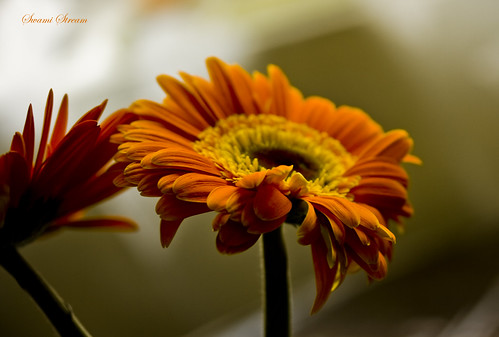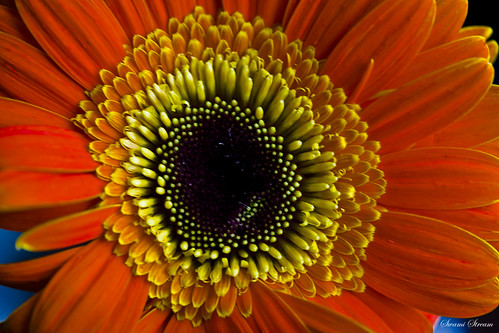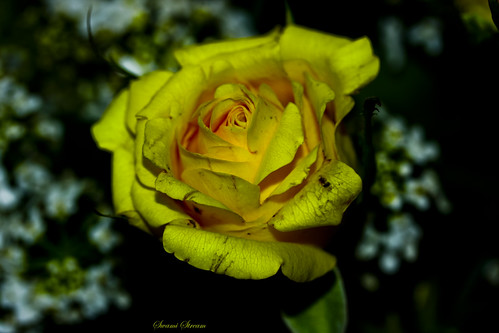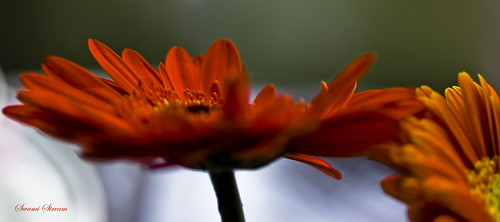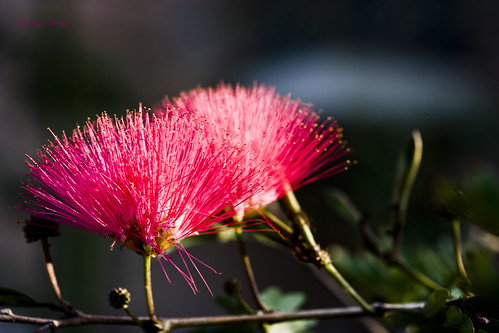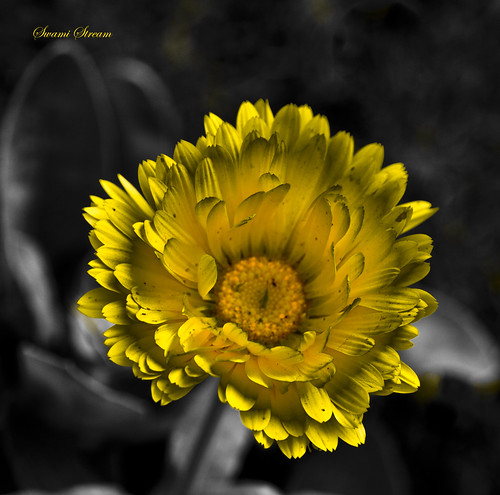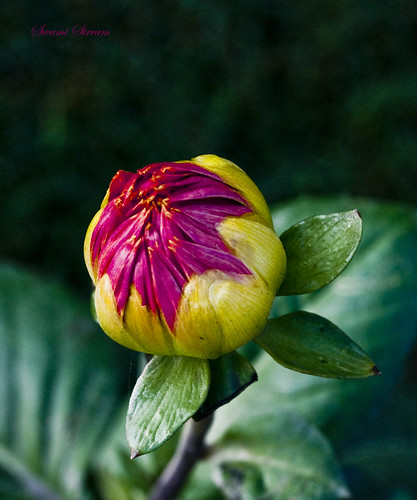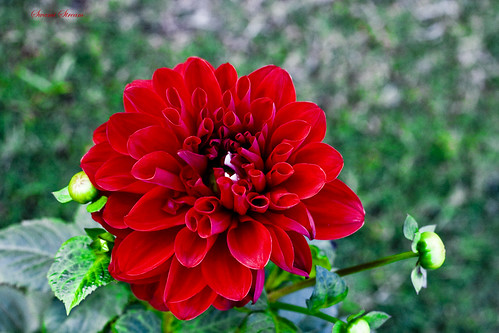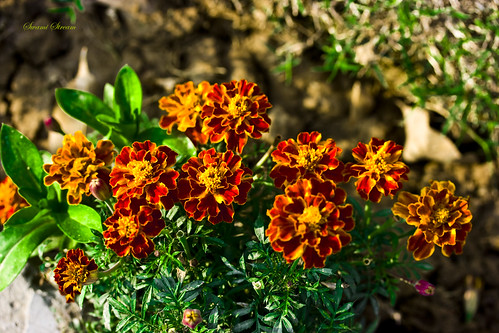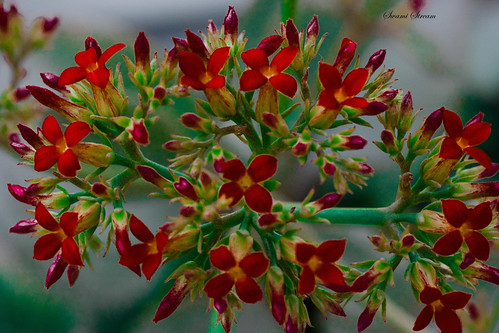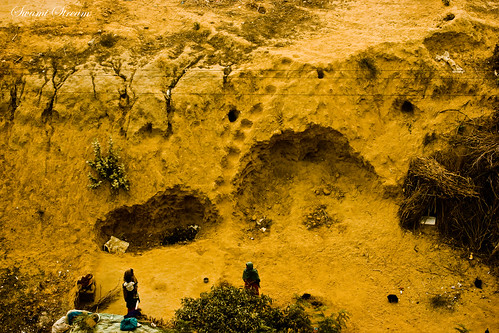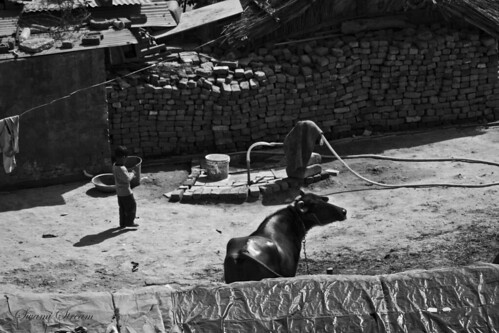Ganesha has many other titles and epithets, including Ganapati and Vigneshvara. The Hindu title of respect Shri (Sanskrit: श्री; śrī, also spelled Sri or Shree) is often added before his name. One popular way Ganesha is worshipped is by chanting a Ganesha Sahasranama, a litany of "a thousand names of Ganesha". Each name in the sahasranama conveys a different meaning and symbolises a different aspect of Ganesha. At least two different versions of the Ganesha Sahasranama exist; one version is drawn from the Ganesha Purana, a Hindu scripture venerating Ganesha.[17]
The name Ganesha is a Sanskrit compound, joining the words gana (Sanskrit: गण; gaṇa), meaning a group, multitude, or categorical system and isha (Sanskrit: ईश; īśa), meaning lord or master.[18] The word gaņa when associated with Ganesha is often taken to refer to the gaņas, a troop of semi-divine beings that form part of the retinue of Shiva (IAST: Śiva).[19] The term more generally means a category, class, community, association, or corporation.[20] Some commentators interpret the name "Lord of the Gaņas" to mean "Lord of Hosts" or "Lord of created categories", such as the elements.[21] Ganapati (Sanskrit: गणपति; gaṇapati), a synonym for Ganesha, is a compound composed of gaṇa, meaning "group", and pati, meaning "ruler" or "lord".[20] The Amarakosha,[22] an early Sanskrit lexicon, lists eight synonyms of Ganesha : Vinayaka, Vighnarāja (equivalent to Vignesha), Dvaimātura (one who has two mothers),[23] Gaṇādhipa (equivalent to Ganapati and Ganesha), Ekadanta (one who has one tusk), Heramba, Lambodara (one who has a pot belly, or, literally, one who has a hanging belly), and Gajanana (IAST: gajānana) ; having the face of an elephant).[24]
Vinayaka (Sanskrit: विनायक; vināyaka) is a common name for Ganesha that appears in the Purāṇas and in Buddhist Tantras.[25] This name is reflected in the naming of the eight famous Ganesha temples in Maharashtra known as the Ashtavinayak (aṣṭavināyaka).[26] The names Vignesha (Sanskrit: विघ्नेश; vighneśa) and Vigneshvara (Sanskrit: विघ्नेश्वर; vighneśvara) (Lord of Obstacles)[11] refers to his primary function in Hindu mythology as the creator and remover of obstacles (vighna).[27]
A prominent name for Ganesha in the Tamil language is Pille or Pillaiyar (Little Child).[28] A. K. Narain differentiates these terms by saying that pille means a "child" while pillaiyar means a "noble child". He adds that the words pallu, pella, and pell in the Dravidian family of languages signify "tooth or tusk of an elephant", but more generally "elephant".[29] Anita Raina Thapan notes that the root word pille in the name Pillaiyar might have originally meant "the young of the elephant", because the Pali word pillaka means "a young elephant"
Source: Wikipedia
Ganesha — the elephant-deity riding a mouse — has become one of the commonest mnemonics for anything associated with Hinduism. This not only suggests the importance of Ganesha, but also shows how popular and pervasive this deity is in the minds of the masses.
The Lord of Success
The son of Shiva and Parvati, Ganesha has an elephantine countenance with a curved trunk and big ears, and a huge pot-bellied body of a human being. He is the Lord of success and destroyer of evils and obstacles. He is also worshipped as the god of education, knowledge, wisdom and wealth. In fact, Ganesha is one of the five prime Hindu deities (Brahma, Vishnu, Shiva and Durga being the other four) whose idolatry is glorified as the panchayatana puja.
Significance of the Ganesha Form
Ganesha's head symbolizes the Atman or the soul, which is the ultimate supreme reality of human existence, and his human body signifies Maya or the earthly existence of human beings. The elephant head denotes wisdom and its trunk represents Om, the sound symbol of cosmic reality. In his upper right hand Ganesha holds a goad, which helps him propel mankind forward on the eternal path and remove obstacles from the way. The noose in Ganesha's left hand is a gentle implement to capture all difficulties.
The broken tusk that Ganesha holds like a pen in his lower right hand is a symbol of sacrifice, which he broke for writing the Mahabharata. The rosary in his other hand suggests that the pursuit of knowledge should be continuous. The laddoo (sweet) he holds in his trunk indicates that one must discover the sweetness of the Atman. His fan-like ears convey that he is all ears to our petition. The snake that runs round his waist represents energy in all forms. And he is humble enough to ride the lowest of creatures, a mouse.
How Ganesha Got His Head
The story of the birth of this zoomorphic deity, as depicted in the Shiva Purana, goes like this: Once goddess Parvati, while bathing, created a boy out of the dirt of her body and assigned him the task of guarding the entrance to her bathroom. When Shiva, her husband returned, he was surprised to find a stranger denying him access, and struck off the boy's head in rage. Parvati broke down in utter grief and to soothe her, Shiva sent out his squad (gana) to fetch the head of any sleeping being who was facing the north. The company found a sleeping elephant and brought back its severed head, which was then attached to the body of the boy. Shiva restored its life and made him the leader (pati) of his troops. Hence his name 'Ganapati'. Shiva also bestowed a boon that people would worship him and invoke his name before undertaking any venture.
However, there's another less popular story of his origin, found in the Brahma Vaivarta Purana: Shiva asked Parvati to observe the punyaka vrata for a year to appease Vishnu in order to have a son. When a son was born to her, all the gods and goddesses assembled to rejoice on its birth. Lord Shani, the son of Surya (Sun-God), was also present but he refused to look at the infant. Perturbed at this behaviour, Parvati asked him the reason, and Shani replied that his looking at baby would harm the newborn. However, on Parvati's insistence when Shani eyed the baby, the child's head was severed instantly. All the gods started to bemoan, whereupon Vishnu hurried to the bank of river Pushpabhadra and brought back the head of a young elephant, and joined it to the baby's body, thus reviving it.
Ganesha, the Destroyer of Pride
Ganesha is also the destroyer of vanity, selfishness and pride. He is the personification of material universe in all its various magnificent manifestations. "All Hindus worship Ganesha regardless of their sectarian belief," says D N Singh in A Study of Hinduism. "He is both the beginning of the religion and the meeting ground for all Hindus.
Uploaded by Swami Stream on 31 May 09, 6.51PM IST.
Ganesha -Destroyer of Obtacles
Adenium Macro Landscape
Close-up of a flower
It is an evergreen succulent shrub in tropical climates and semi-deciduous to deciduous in colder climates, is also dependent on the subspecies or cultivar. Growing to 1-3 m in height, with pachycaul stems and a stout, swollen basal caudex. The leaves are spirally arranged, clustered toward the tips of the shoots, simple entire, leathery in texture, 5-15 cm long and 1-8 cm broad. The flowers are tubular, 2-5 cm long, with the outer portion 4-6 cm diameter with five petals, resembling those of other related genera such as Plumeria and Nerium. The flowers tend to red and pink, often with a whitish blush outward of the throat.
Uploaded by Swami Stream on 31 May 09, 6.03AM IST.
Adenium Flower
The flower @ home.
Adenium is a genus of flowering plants in the family Apocynaceae, containing a single species, Adenium obesum, also known as Sabi Star, Kudu or Desert-rose. It is native to tropical and subtropical eastern and southern Africa and Arabia.
Close-up of a flower
It is an evergreen succulent shrub in tropical climates and semi-deciduous to deciduous in colder climates, is also dependent on the subspecies or cultivar. Growing to 1-3 m in height, with pachycaul stems and a stout, swollen basal caudex. The leaves are spirally arranged, clustered toward the tips of the shoots, simple entire, leathery in texture, 5-15 cm long and 1-8 cm broad. The flowers are tubular, 2-5 cm long, with the outer portion 4-6 cm diameter with five petals, resembling those of other related genera such as Plumeria and Nerium. The flowers tend to red and pink, often with a whitish blush outward of the throat.
Source:Wikipedia
Uploaded by Swami Stream on 30 May 09, 5.34PM IST.
Orange Gerbera Macro
Gerbera macro shot at home , was playing with focus when I shot the series
Uploaded by Swami Stream on 28 May 09, 8.00PM IST.
Orange Gerbera Macro
Gerbera is a genus of ornamental plants from the sunflower family (Asteraceae). It was named in honor of the German naturalist Traugott Gerber, a friend of Carolus Linnaeus.
It has approximately 30 species in the wild, extending to South America, Africa and tropical Asia. The first scientific description of a Gerbera was made by J.D. Hooker in Curtis's Botanical Magazine in 1889 when he described Gerbera jamesonii, a South African species also known as Transvaal daisy or Barberton Daisy.
Gerbera species bear a large capitulum with striking, two-lipped ray florets in yellow, orange, white, pink or red colors. The capitulum, which has the appearance of a single flower, is actually composed of hundreds of individual flowers. The morphology of the flowers varies depending on their position in the capitulum. The flowers can be as small as 7 cm (Gerbera mini 'Harley') in diameter or up to 12 cm (Gerbera ‘Golden Serena’).
Gerbera is very popular and widely used as a decorative garden plant or as cut flowers. The domesticated cultivars are mostly a result of a cross between Gerbera jamesonii and another South African species Gerbera viridifolia. The cross is known as Gerbera hybrida. Thousands of cultivars exist. They vary greatly in shape and size. Colors include white, yellow, orange, red, and pink. The center of the flower is sometimes black. Often the same flower can have petals of several different colors.
Gerbera is also important commercially. It is the fifth most used cut flower in the world (after rose, carnation, chrysanthemum, and tulip).[citation needed] It is also used as a model organism in studying flower formation. Gerbera contains naturally occurring coumarin derivatives. Gerbera is a tender perennial, and is therefore an annual in temperate climates.
Source:Wikipedia.com
Uploaded by Swaminathan on 26 May 09, 8.44PM IST.
Yellow Rose
Yellow rose shot at home sometime back. I am not taking any new shots will have to start that .
Uploaded by Swami Stream on 24 May 09, 8.18PM IST.
Orange Dahlia Bud
Dahlia is a certain genus of healthy, tuberous, perennial plants indigenous to southern Mexico, other Central America, and eastern Colombia. There at least thirty six different species of Dahlia. Dahlia hybrids generally are usually produced as decorative garden plants. The Aztecs gathered and worked on the dahlia for excellent food, ceremony, as good as enhancing purposes, and the slow woody stem of single variety was treated for low flexible pipes.
In 1872 a tiny box of Dahlia roots also were sent out from southern Mexico to the southern Netherlands. Only one healthy plant survived the long trip, but gave great red hot flowers with sharp petals. Nurserymen in eastern Europe bred from this beautiful plant, which was called Dahlia juarezii with other parents of Dahlias discovered first and these also are the actual progenitors of all new Dahlia hybrids. Ever since, physical plant breeders also have been keeping Dahlias to make thousands of cultivars, mostly chosen for their beautiful and brightly coloured flowers. Dahlia plants vary in height from as small as twelve inches to as high as six to eight feet. The beautiful flowers can often be as low as two inches or up to a foot in its diameter . The large cultural variety results from Dahlias being octoploids (they also have eight different sets of homologous chromosomes , whereas most other plants have no more than 2) .
The dahlia is called after Swedish 18th century botanist Anders Dahl. Until lately they once were also identified in southern Germany as "georgine" by the eminent botanist Carl Ludwig Willdenow, after the famous naturalist Johann Gottlieb Georgi of greater St. Petersburg.
Uploaded by Swami Stream on 23 May 09, 6.56PM IST.
Mumbai's Eiffel Tower|Explore|
This is the Doordarshan TV tower in Mumbai one landmark you can see from anywhere across mumbai if you go on high rise building . Gone are the days of Terrestiral channels but the tower still stands
My First shot on Flickr Explore
Uploaded by Swami Stream on 18 Jun 07, 7.25PM IST.
Red Powderpuff
Beautiful bottle brush flower shot @ Uniworld garden , Gurgaon.
This flower is called Calliandra haematocephala...
Uploaded by Swami Stream on 21 May 09, 7.35PM IST.
Selectively Coloured
Shot this beautiful bud at home. Its a daisy bud . just selectively reduced the green .
Daisy Depth shot
Shot in our complex garden in spring . The heat in gurgaon has shown some mercy today morning its not as roasting lke yesterday.
Budding Dahlia
Shot of a budding dahlia at Uniworld Garden in Gurgaon , haryana.
Red Dahlia
Red dahlia shot at uniworld gardens in Spring . Good time to remember all the beautiful blooms. the city of Gurgaon is frying today 2 43 Degreed C
Red flower macro
beautiful macro shot at home. Shot them sometime back played with the lumination and saturation for this one.
Life
I have been trying to upload this one for a while now, just realized that it was not getting uploaded due to size . I shot this from my balcony where these people moved their hut from top of to down the small hillock and u can see the steps too .
Qutub Minar
A shot from my archives
Inspired by the Minaret of Jam in Afghanistan and wishing to surpass it, Qutb-ud-din Aibak, the first Muslim ruler of Delhi, commenced construction of the Qutb Minar in 1193, but could only complete its base. His successor, Iltutmish, added three more stories and, in 1386, Firuz Shah Tughluq constructed the fifth and the last story. The development of architectural styles from Aibak to Tughluq are quite evident in the minaret. Like earlier towers erected by the Ghaznavids and Ghurids in Afghanistan, the Qutb Minar comprises several superposed flanged and cylindrical shafts, separated by balconies carried on Muqarnas corbels. The minaret is made of fluted red sandstone covered with intricate carvings and verses from the Qur'an. The Qutb Minar is itself built on the ruins of Lal Kot, the Red Citadel in the city of Dhillika, the capital of the Tomars and the Chauhans, the last Hindu rulers of Delhi.
The purpose for building this monument has been variously speculated upon. It could take the usual role of a minaret, calling people for prayer in the Quwwat-ul-Islam mosque, the earliest extant mosque built by the Delhi Sultans. Other possibilities are a tower of victory, a monument signifying the might of Islam, or a watch tower for defense. Controversy also surrounds the origins for the name of the tower. Many historians believe that the Qutb Minar was named after the first Turkish sultan, Qutb-ud-din Aibak but others contend that it was named in honour of Qutbuddin Bakhtiar Kaki, a saint from Baghdad who came to live in India and was greatly venerated by Iltutmish.
The nearby Iron Pillar is one of the world's foremost metallurgical curiosities, standing in the famous Qutb complex. According to the traditional belief, anyone who can encircle the entire column with their arms, with their back towards the pillar, can have their wish granted. Because of the corrosive qualities of sweat the government has built a fence around it for safety.
Daisy
Daisy macro shot at home before the heat made them wither away .
Shot with Canon Xti rebel with 60 mm Macro lens
buffalo in the sun
buffalo shot from my balcony. the kid was playing next to it. I used a tamaron 70-300 mm to shoot this.
The Quest for Fun
saw the kids all came together and chatted for a few minutes before this . Then they suddenly started walking is different directions searching for something .
Lets catch something
These boys were playing near this pond and trying to catch a frog I guess. The boy leaning forward had a sack in his hand . Another shot from my balcony.



